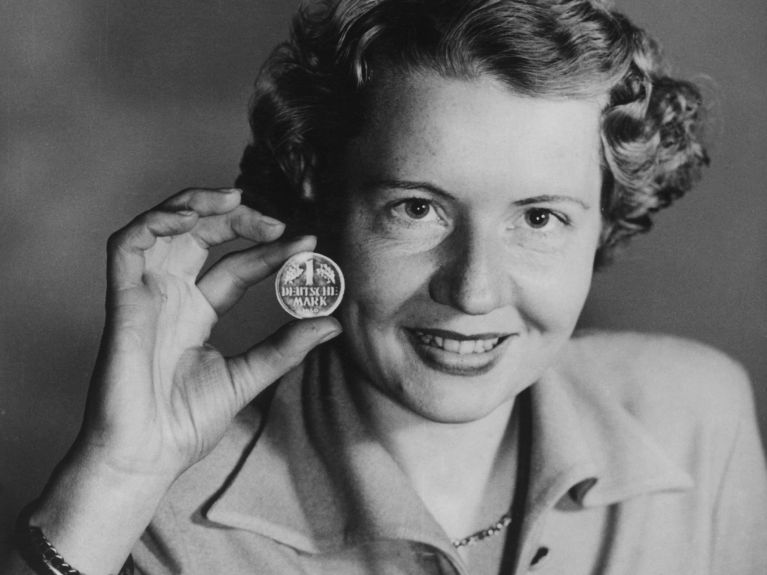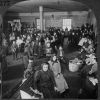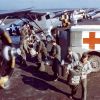History part 3: The path to democracy
The new beginning after the Second World War: The USA supported Germany in establishing a democratic society.

The Second World War changed the United States. With its newly gained military and economic might came the will to try to, indeed to have to, assume more global responsibility. The same applied to Germany as the country that had lost the War: It was less a matter of punishing the country, as the USA was more interested in helping it get back on its feet and become a democracy. This was already evident at the Potsdam Conference in the summer of 1945, where the Allies sat down to ponder the future of the former aggressor. Agreement was reached on four resolutions, the four Ds: demilitarisation, denazification, decentralisation, and democratisation. The USA wanted Germany to be able to start anew.
War criminals before the Nuremberg tribunal
So how could this be achieved? Could an entire people be “re-educated” in democracy? The Nuremberg Trials started in the winter of 1945 and spelled the first attempt in this regard. It was completely new to initiate a tribunal to judge the crimes of the losing side in a war. The objective was to make certain Germans did not feel the entire population was being held responsible and sentenced for the War. This sent a clear signal to the population: Those tried for war crimes are the guilty ones, not the population as a whole. At the same time, the atrocities of the Third Reich were unsparingly exposed. The trials were intended as a prime example of the fundamental mechanisms of a democracy.

Marshall Plan for reconstruction
In March 1947 President Harry S. Truman reiterated that the United States was committed to a new approach of taking on more responsibility in the future, particularly in Europe. In the Truman Doctrine named after him, the USA championed its role as the protector of free peoples. This was a provocation for the Soviet Union and the Cold War ensued. However, German-American relations stepped up a level. On 5 June 1947, US Secretary of State George C. Marshall laid the foundations for a programme for European reconstruction, the wide-ranging economic European Recovery Program (ERP) or Marshall Plan – also laying the basis for the German “Economic Miracle”.

The Airlift as a symbol of friendship
Just how close the relations between the USA and Germany had become was evidenced by the US response to the Berlin Blockade in the summer of 1948. Following tensions with the Western Allies and as a response to the currency reform in Germany, the Soviet Union blocked all routes to West Berlin. Two million people were cut off from access to food and raw materials. The USA decided to airlift supplies to the enclave – for over a year. The Raisin Bombers air-dropped care packages – keeping the Berliners in a steady supply of cans of corned beef, bacon, coffee, chocolate, and of course raisins. The airplanes became a symbol of the deep Transatlantic friendship with a clear signal: We won’t leave you in the lurch!
Dieses YouTube-Video kann in einem neuen Tab abgespielt werden
YouTube öffnenThird party content
We use YouTube to embed content that may collect data about your activity. Please review the details and accept the service to see this content.
Open consent formFoundation of two Germanies
On 23 May 1949 the Federal Republic of Germany was established and, a few months later, as a response by the Russians, the German Democratic Republic (GDR). Establishing democracy in Germany became a crucial issue for the USA. Firstly, the idea was to create a pluralist constitutional state, with a system of representation, the division of powers and free, independent elections.
At the same time, much more was involved: The USA wanted to give the Germans, with whom they still felt a bond despite two World Wars, the opportunity to leave their Nazi past behind them. The Germans were to overcome nationalism, militarism and an authoritarian mindset and evolve into a functioning, democratic society. And they wanted to do so not as victors imposing something on the vanquished, but as a friend helping another friend get back on the straight and narrow.

Close integration into Western alliances
The commitment paid off. With the Americans’ assistance, the Federal Republic of Germany gained in strength, both in military and economic terms, and became ever more integrated into the system of Western alliances. It became a member of international organisations such as the European Coal and Steel Community (from 1951 onwards), NATO (from 1955 onwards), the West European Union (from 1955 onwards) and the European Economic Community (from 1957 onwards). It is a period defined by stabilisation and reconstruction.



